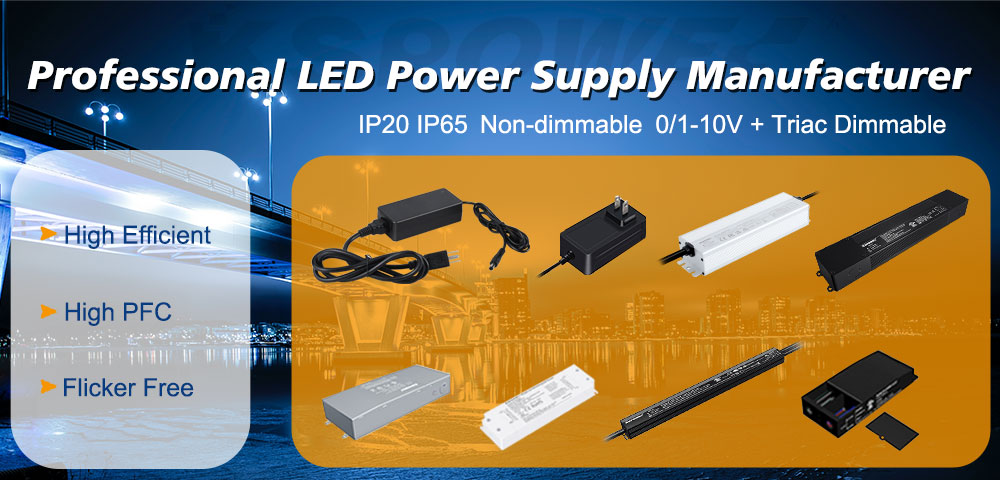
Privacy statement: Your privacy is very important to Us. Our company promises not to disclose your personal information to any external company with out your explicit permission.
![]() December 03, 2019
December 03, 2019

The LED driving Power Supply exists as a component of the LED lamp. When the LED driving power source and the LED module are respectively placed, the output port of the LED driving power source and the LED module input port must meet the requirements of this standard: can withstand 2kV between the line and the line. Surge impact of 4kV between line and ground (ie, differential mode 2KV, common mode 4KV standard). At the same time, this is also required for the AC power port of LED lamps.
At present, LED outdoor driving power supply is still a difficult problem to solve in lightning protection. Of course, the development of electronic technology to the present is not a big challenge from the technical point of view. Just because LED lamps have requirements and limitations on the overall size of the power supply, it is still necessary to design a power supply that meets lightning protection requirements in a limited space. Not so easy. Generally, the current GB/T17626.5 only recommends that the product meet the standard of differential mode 2KV and common mode 4KV. In fact, this specification is far from meeting the actual requirements, especially for special conditions such as port terminals, factories with large electromechanical equipment in the vicinity or lightning strike-prone areas.
In order to resolve this contradiction, many engineering companies often solve this problem by adding an independent surge suppressor. By adding an independent lightning protection device between the input and the outdoor LED driving power supply (not limited to the LED driving power supply, which can be generally referred to as electronic equipment, the same below), thereby solving the threat of lightning strike on the outdoor LED driving power, thereby greatly ensuring The reliability of the power supply. It is necessary to point out that for stand-alone lightning protection devices, the reference standard is different from the integrated power supply lightning protection standard, and the reference standard is IEC61643-1 or EN61643-11. Stand-alone lightning arresters are generally composed of multi-stage protection lines. In order to protect the power supply equipment of the latter stage, it must ensure that the residual voltage after multi-stage protection is less than the surge voltage that the back-end power supply can withstand. The smaller the value, the better, generally less than 1.5KV, better design products This value can be lower than 0.8KV.
In fact, in addition to lightning strikes, the power supply is switched on and off, capacitive, capacitive or large loads, switching of power systems, resonance phenomena associated with switching devices, and various system faults such as system combinations for grounding systems. Both short-circuit and arc faults produce high transient overvoltages (or overcurrents). For example, a high-power drive power supply will generate a large surge current into the power supply device at the turn-on instant, especially in the cold start condition, because there are many different capacitors in the power supply, especially for PFC (power factor). Adjusting the high-voltage, large-capacity electrolytic capacitor after the line, the voltage is very low before starting, and the capacitor is quickly charged in a short time after the mains is turned on. The peak current is far greater than the input current under steady-state conditions.
If it is turned on at the same time when the input voltage is 90 degrees, the inrush current will be larger at this time.
How to ensure that the outdoor Led Driver Power Supply meets the requirements of lightning protection. In addition to designing the corresponding lightning protection circuit, the stress capability of the component must be fully considered, especially the varistor, discharge tube, rectifier bridge, fuse, EMI filter at the input end of the power supply. For devices, take full account of the level of surge that may be tolerated. At least ensure that the relevant requirements such as GB/T17625.6 (equivalent to IEC61000-4-5:2005) or IEC61643-1 or EN61643-11 are met.
In addition, there are some considerations regarding the proper installation and use of the drive power. If the power supply must be grounded reliably, to ensure that the impact energy has a fixed path to vent; use a dedicated line to supply power to the outdoor drive power source, avoid large mechanical and electrical equipment around to avoid the surge impact when the electromechanical equipment starts; reasonably control each branch The total load of the lamps (or power supply) on the road, to avoid the surge shock caused by the load being too large; the reasonable configuration of the knives, the opening or closing must be carried out step by step. These can effectively avoid the surge of operation, so that the led driver power supply can work more reliably.
The above is the Explain the lightning protection requirements of outdoor LED driver we have listed for you. You can submit the following form to obtain more industry information we provide for you.
You can visit our website or contact us, and we will provide the latest consultation and solutions
Send Inquiry
Most Popular
lastest New
Send Inquiry

Privacy statement: Your privacy is very important to Us. Our company promises not to disclose your personal information to any external company with out your explicit permission.

Fill in more information so that we can get in touch with you faster
Privacy statement: Your privacy is very important to Us. Our company promises not to disclose your personal information to any external company with out your explicit permission.